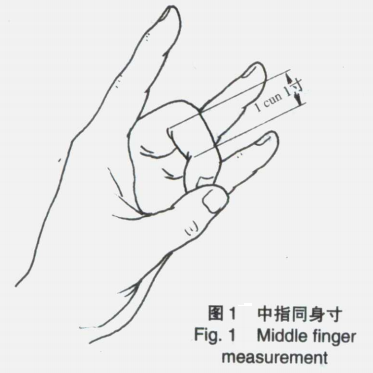- 签证留学 |
- 笔译 |
- 口译
- 求职 |
- 日/韩语 |
- 德语
指寸定位法是在骨度分寸的基础上,用手指比量取穴的方法。人的手指与身体其他部分有一定的比例,临床上医者多以自己的手指比量,但必须参照被取对象身材的高矮适当增减比例。指寸定位法包括以下三种:
1.中指同身寸:中指屈曲时,以中指中节桡侧两端纹头之间的距离作为1寸(图1)。此法适用于四肢取穴的直寸及脊背取穴的横寸。
2.拇指同身寸:以拇指指关节横纹的宽度作为1寸(图2)。此法适用于四肢部的直寸折量。
3.横指同身寸:又名“一夫法”。食、中、无名、小指四指并拢,以中指近端指关节横纹处为准,四指的宽度作为3寸(图3)。此法多用于下肢、下腹部的直寸和背部的横寸。
Finger measurement method is based on proportional measurement method, which uses finger as measurement guide.
Clinically the practitioners use their own fingers for measurement, but have to account for patients' size and height and calculate the proportional measurement accordingly. There are three finger measurement methods:
1. Middle finger measurement:the length between the two medial ends of the crease of the patient's bent middle
finger, which is one cun (Fig. 1). This method is suitable for the longitudinal cun on the extremities and for the transverse measurement on the back, off the spine.
2. Thumb measurement:the width of the phalangeal joint of the patient's thumb, which is one cun (Fig. 2). This method is best used for longitudinal measurement on extremities.
3. Four-finger measurement:or palm, hand measurement -The maximum width of the four fingers (namely, index finger, middle finger, ring finger, and little finger) held together with the thumb abducted is taken as a unit of measurement of 3 cun (Fig. 3). This method is mostly used for lower extremities, longitudinal measurement of the lower abdomen and transverse measurement of the back.



责任编辑:admin
